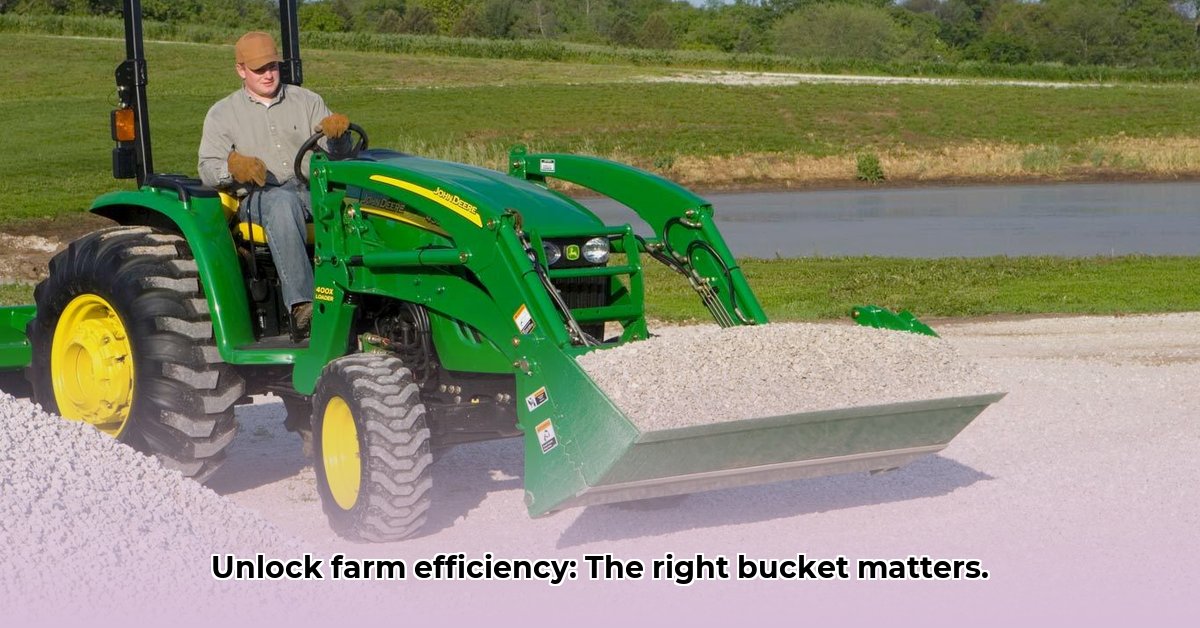
Matching Your Tractor Bucket to the Job: Understanding Your Needs
Before selecting a tractor bucket, carefully consider its intended applications. Different tasks demand different bucket designs. Choosing the right bucket is crucial for maximizing efficiency and minimizing wear and tear on your equipment. For John Deere tractor bucket forks, check out this helpful resource.
Light-duty tasks: For light work, such as moving topsoil or light landscaping, a smaller, lighter-duty bucket suffices. Think of it like choosing a teaspoon instead of a shovel for a small task.
Heavy-duty applications: Heavy digging, moving substantial materials, or demolition require a robust, heavy-duty bucket, ideally constructed from strong materials like Hardox 450 steel. These are the workhorses of the bucket world, built for longevity and performance under intense stress.
Specialized operations: Specific jobs, like root removal or trench digging, benefit from specialized buckets with features like extra-sharp cutting edges or reinforced sides; these are precision instruments for targeted tasks.
The type of material being moved is also vital. Loose soil requires a different bucket design than dense clay or gravel. A bucket optimized for sand will differ significantly from one designed for moving rocks. Incorrect bucket selection can reduce efficiency dramatically.
Key Features to Consider: Building the Perfect Bucket
Several key features significantly impact a bucket's performance and lifespan.
Material: While various steels are available, Hardox 450 steel stands out for its exceptional strength, wear resistance and durability. While more expensive upfront, its longevity often makes it a cost-effective choice for heavy-duty applications. Cheaper steel alternatives typically offer shorter lifespans.
Capacity: The bucket's capacity (the amount of material it can hold) must match your tractor's capabilities. An oversized bucket strains the tractor, while an undersized bucket reduces efficiency. Finding the right balance is crucial.
Cutting Edge: Sharp cutting edges are essential for efficient material movement. Buckets with replaceable cutting edges are a smart investment, allowing for easy replacement when dull, extending the bucket's overall lifespan.
Quick-Attach Systems: These systems facilitate quick changes between attachments, saving significant time. The added cost is often justified by the substantial time savings and increased versatility.
Tooth Bars: For tough jobs, a tooth bar significantly enhances digging power, especially in compacted soil or hard materials. This feature is invaluable for applications requiring superior material breakout force.
Making Your Purchase Decision: Weighing the Pros and Cons
Investing in a high-quality tractor bucket is a long-term investment that pays off handsomely. The table below summarizes the advantages and disadvantages of key features.
| Feature | Pros | Cons |
|---|---|---|
| Hardox 450 Steel | Extreme strength, durability, very long lifespan | Higher upfront cost |
| Quick-Attach System | Faster attachment changes, increased versatility | Slightly more expensive than non-quick-attach systems |
| Replaceable Cutting Edge | Extends bucket life, reduces repair costs | Requires additional cost for replacement edges |
| Tooth Bar | Improved digging performance in tough soils, better material breakout | Might add a little weight and potentially reduce bucket capacity |
Customizing Your Tractor Bucket: A Perfect Fit for Your Farm
Many manufacturers offer customization options, enabling you to tailor the bucket to your specific needs and soil conditions. Consider options like specialized cutting edges and reinforced tooth bars. A customized bucket often proves more efficient and durable in the long run.
How to Choose the Best Custom Tooth Bar for Your Compact Tractor Bucket
Choosing the right custom tooth bar maximizes the efficiency of your compact tractor bucket. The following steps will guide you in making an informed decision.
Understanding Your Needs: Prioritize Your Tasks
Before focusing on specifics, assess your workload. The tasks you perform most often dictate the type of tooth bar needed. A heavy-duty bar for rocky terrain differs significantly from a bar for general excavation.
Assessing Compatibility: Precise Measurement
Precisely measure your bucket and ensure the tooth bar's dimensions precisely match. Improper fit compromises both safety and efficiency. Consult the manufacturer or your equipment dealer if necessary.
Material Matters: Durability and Longevity
High-strength steel, such as Hardox, is preferred for its resistance to abrasion and impact. However, consider thickness and heat treatment; thicker, properly hardened bars last longer, reducing replacement costs.
Tooth Design and Spacing: Optimized Performance
Tooth spacing and design influence performance. Closer spacing is ideal for compacted soil or rocky material, while wider spacing suits lighter applications. Consider the tooth shape, as some are optimized for specific tasks like sod removal.
Installation Ease: A Secondary Consideration
While convenient, ease of installation shouldn't overshadow other crucial factors. A quickly installed but flimsy bar will prove inefficient and costly in the long run.
Brand Comparison and Reviews: Informed Decisions
Research various brands and compare their offerings through reviews and feedback from online forums. Pay attention to reported durability, installation ease, and user satisfaction.
Long-Term Costs: Total Cost of Ownership
Consider the long-term cost. A durable bar might have a higher initial cost but saves money through reduced replacement costs compared to cheaper, less durable alternatives.
Customizing Your Choice: Tailoring to Your Needs
Explore customization options offered by manufacturers, allowing for specific tooth configurations, length adjustments, or material selection, ensuring a perfect fit for your unique needs. This ensures the tooth bar ideally suits your specific applications.